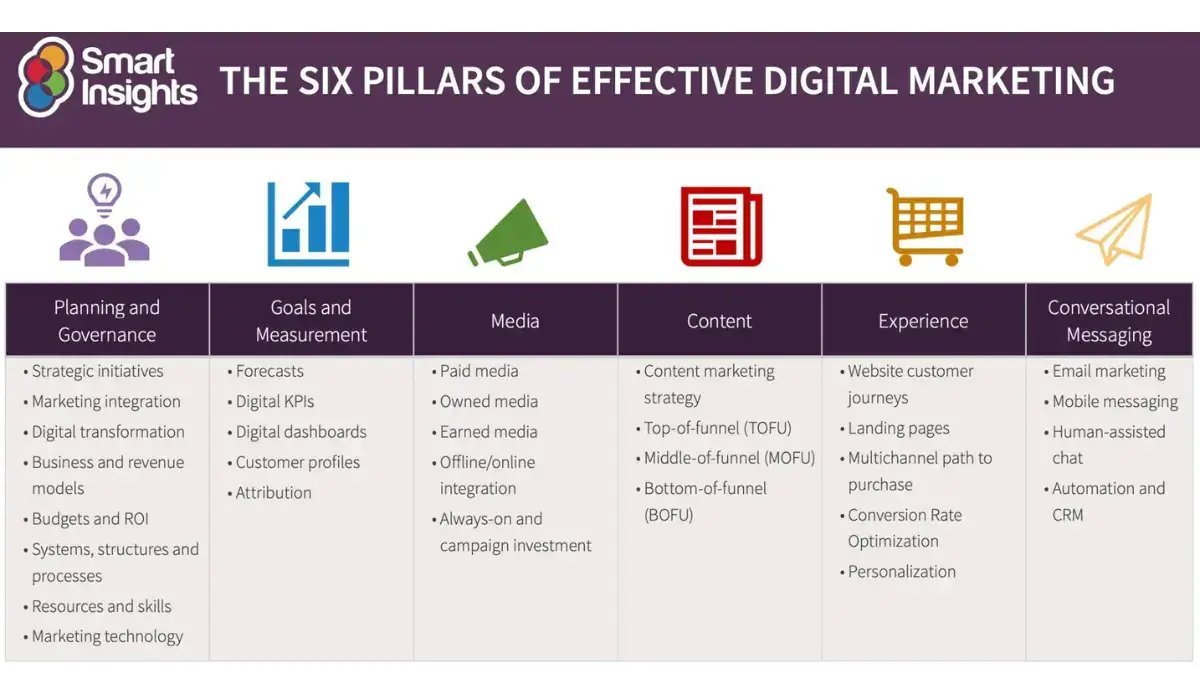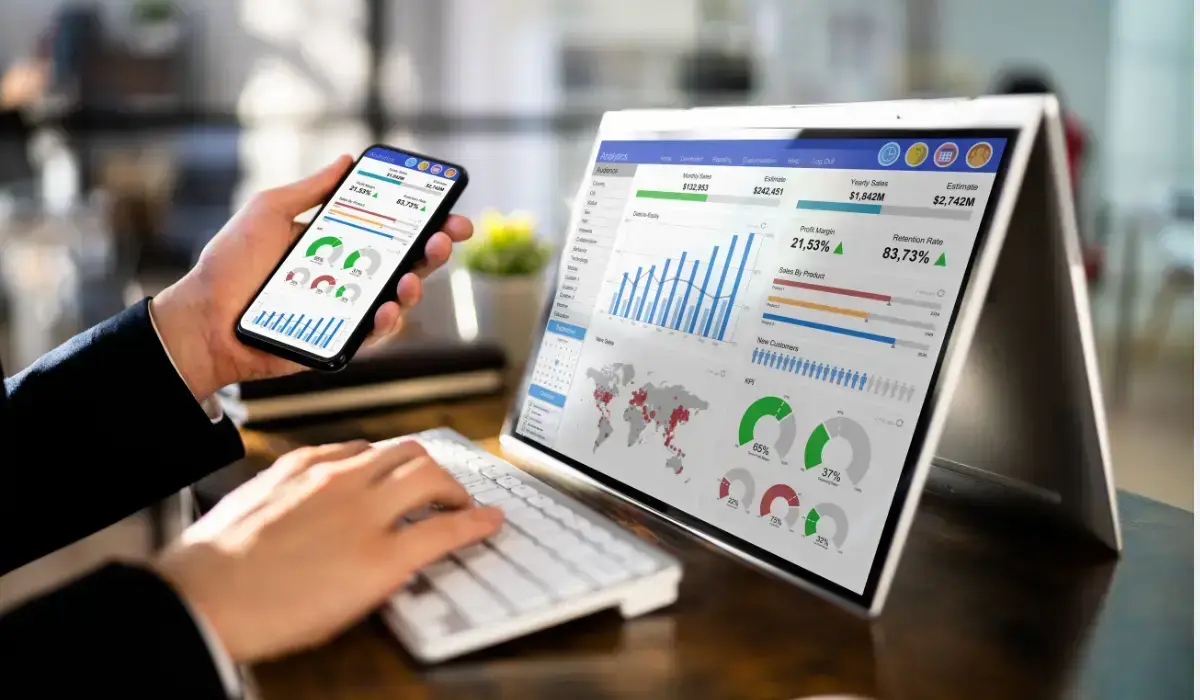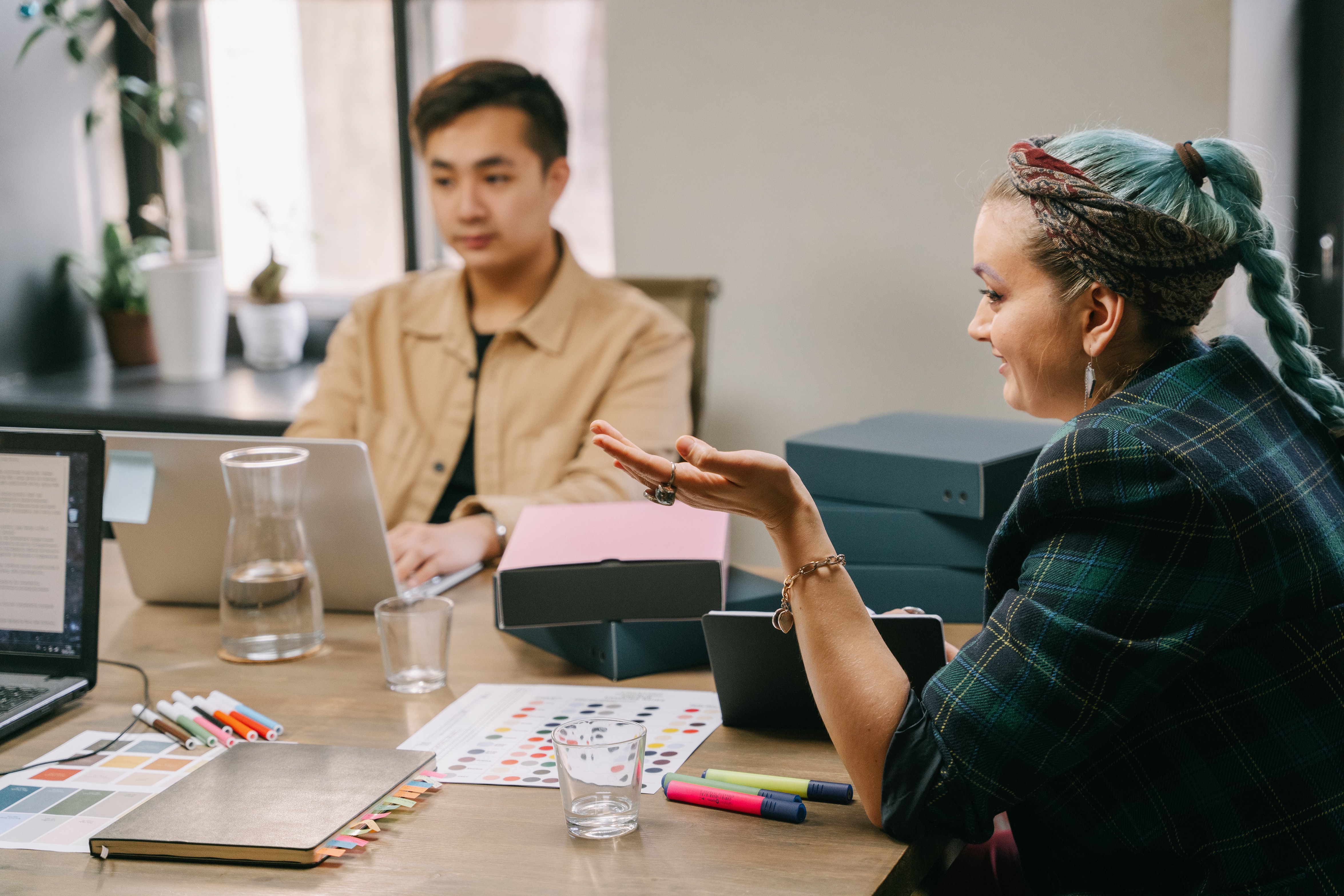For any business to succeed, it must master marketing to its target audience or demographic. Small to medium businesses or SMBs especially have to market to outperform their competition and capture as much traffic as possible from limited customer pools.
*Updated 9/29/2024
If your SMB marketing needs a bit of a boost, you’ve come to the right place. Today, let’s break down how to create an effective SMB marketing strategy step-by-step.
Shortcuts:
- What is SMB Marketing?
- 5-Step SMB Marketing Strategy
- Small Business Marketing Tips
- Top Marketing Tools for Small Business
- FAQ: SMB Marketing

What is SMB Marketing?
SMB marketing is the process by which small and medium-sized businesses (SMBs) create strategies to promote their products and services.
Unlike large corporations, SMBs must tailor their marketing efforts to budget constraints and their specific customer base. This often involves a mix of both traditional and digital marketing methods to maximize results.
If you strategize your marketing efforts, you’ll be much more likely to:
- Build long-term relationships with your target consumers
- Advertise to your target audience members
- Advertise effectively to the people most likely to buy from your brand
All businesses need marketing strategies to thrive. For example, a dental office might use a marketing strategy plus tools like GetWeave to maximize its attractiveness to clients and patients.
5-Step SMB Marketing Strategy
- Set your goals
- Identify your baseline and key metrics
- Choose industry-specific marketing tactics
- Select the right marketing channels
- Measure results, adjust, optimize, and test again
Now that you know the importance of an effective marketing strategy, let’s break down how to develop one step-by-step.
1. Set your goals
Firstly, you need to set the right goals for your SMB. Small to medium businesses like yours often need to target specific metrics to grow effectively and on schedule.
For example, most SMBs want to increase their revenue or get more leads. Regardless of the goals you choose, remember to keep those goals S.M.A.R.T.

Source: Indeed
What does S.M.A.R.T. stand for?
- Specific
- Measurable
- Actionable
- Relevant
- Timely
SMART goals for most small to medium businesses are things like increasing revenue by a specific percentage, getting a certain number of leads, and so on.
Keeping your goals specific will help you use the right marketing strategies and tools for your needs.
For instance, you may target customers, leads, and website visitors or redo your website or online store for better performance and search engine optimization (SEO).
Bottom line: figure out what goals you want to achieve through your marketing, then move on from there.
2. Identify baseline and key metrics
The next major step is to identify the right marketing metrics and a baseline or starting point against which you can measure them.
A baseline, in a nutshell, helps you determine which of your marketing tactics or tools generate the right numbers or improvements for your overall goals mentioned above.
Say that you aim to increase website traffic by a specific percentage or visitor count. Your baseline could be your current visitor count or all-time high visitor count, as previously recorded over your business’s lifespan.
Now that you have a baseline, you know what improvement looks like should your marketing efforts be successful. You should also determine key metrics, or KPIs, to help you measure that success, like revenue, visitor count, total traffic on a single day, etc.
These metrics depend on your goals and your business, of course. So take a while to think of the metrics you want to focus on before moving to the next step.
3. Choose industry-specific marketing tactics

When it comes to small business marketing, a one-size-fits-all approach rarely works. Each industry has unique challenges, audience behaviors, and competitive landscapes, making it essential to develop tailored strategies.
Now that you know what to look for and how to measure success, it’s time to pick out the right marketing tactics to achieve that success. Broadly speaking, most marketing tactics are one of two types:
- Digital marketing tactics: These employ various digital channels, such as your website or search engines, to reach your target audience and convert visitors into paying customers.
- Traditional marketing tactics: These employ offline or traditional marketing channels to reach your audience members, like TV ads, billboards, posters, etc.
For example, retail businesses may benefit from social media ads and influencer marketing, while service-based industries might focus more on SEO and content marketing to educate potential clients.
Generally, most SMBs need to combine both digital and traditional marketing tactics to see success. There's one exception: e-commerce businesses.
How to Develop Industry-Specific Marketing Tactics
- Analyze competitors: Study what your competitors are doing well and identify gaps in their marketing strategies.
- Understand audience behavior: Research your target audience’s preferences, online habits, and decision-making processes within your industry.
- Identify top performing channels: Determine which marketing channels (social media, SEO, PPC, etc.) work best for your specific industry.
- Tailor campaigns to industry trends: Stay updated on trends within your sector and design marketing campaigns that resonate with your audience’s current needs.
- Use case studies and success stories: Reference industry-specific success stories to guide your approach and validate your marketing efforts.
4. Select the right marketing channels

Source: Shop OnCloud
The next major step is selecting the right marketing channels for your brand and overall business goals.
Common SMB marketing channels
- Content marketing: Content marketing involves creating and sharing valuable, relevant content to attract and engage your audience. This can include blog posts, videos, infographics, and other forms of media that provide solutions or insights to your target market.
- Search Engine Optimization (SEO): SEO focuses on improving your website's organic search ranking, helping your business appear in front of users actively searching for relevant products or services. By optimizing your website for search engines, you can increase visibility and drive long-term, organic traffic.
- Social media marketing: Social media marketing enables businesses to connect with their audience on platforms like Facebook, Instagram, LinkedIn, and X (formerly Twitter). It’s an excellent channel for brand awareness, community engagement, and driving traffic to your website.
- Email marketing: Email marketing is one of the most cost-effective ways to nurture leads and retain customers. Regularly sending newsletters, promotional offers, and personalized emails helps maintain customer relationships and encourages repeat business.
- Micro-influencer marketing: Collaborating with micro-influencers allows businesses to leverage the trust and reach of popular figures in their industry. Influencers can introduce your brand to a larger, engaged audience, increasing brand awareness and credibility.
- Offline marketing: While digital channels dominate SMB marketing, offline marketing strategies like direct mail, print ads, and local events still play a role. These tactics can help you reach local audiences and build personal relationships, particularly in service-based industries.
If you aren’t sure what marketing channels to leverage, look at what your competitors use. If they work for your competitors, odds are they will also work for you since you are competing for the same target audience.
Considerations when choosing marketing channels and tactics
- Budget: Social media ads can offer cost-effective targeting but may require ongoing investment to maintain visibility.
- Business goals: If you're aiming for long-term growth, Search Engine Optimization (SEO) should be a core tactic for sustained organic traffic.
- Resources: Some channels, like SEO and blogging, require significant time and expertise, whereas paid ads can yield faster results.
5. Measure results, adjust, optimize, and retest

Lastly, you can improve and optimize your SMB marketing strategy by measuring long-term results. As you put out your first ads and bring your first customers to your site, gather as much data as you can and determine:
- Which ads or marketing channels are most successful?
- How do your target audience members respond to your marketing efforts?
- Where can you improve your website, marking materials, and campaigns?
Analyzing your marketing results and improving is the number one way to master SMB marketing overall. It’s also the only way you’ll be able to wring as much value from every marketing dollar you spend as possible.
For example, say that you put out a bunch of Google PPC ads. Over time, you should measure the performance of those ads and figure out which ones bring the most people to your website.
Then you can design future advertisements like the most successful ones you already have up and running.
Small Business Marketing Tips
Here are some key small business marketing ideas to ensure you get the most out of your efforts:
- Leverage social media: Social platforms like Facebook, Instagram, and LinkedIn can help you reach your target audience effectively. Consistently engaging with your followers can help build a loyal customer base.
- Invest in email marketing: Email campaigns remain one of the most cost-effective forms of digital marketing for small businesses. Regularly sending newsletters, promotional offers, and product updates can keep your customers engaged and encourage repeat purchases.
- Use data analytics: Tools like Google Analytics can provide insights into the effectiveness of your campaigns. By tracking metrics like traffic, conversion rates, and engagement, you can make data-driven decisions to optimize your marketing efforts.
- Collaborate with micro-influencers: Partnering with micro-influencers who align with your brand can drive awareness and traffic to your business, often at a lower cost than traditional advertising.
Top Marketing Tools for Small Businesses

Source: LinkedIn
To implement your small business marketing plan effectively, using the right tools to streamline tasks, enhance productivity, and provide measurable results is important. Below are some top marketing tools that can help you optimize your marketing efforts:
1. Social media management platforms
Managing multiple social media platforms can be time-consuming. Social media management tools allow you to schedule posts, track engagement, and analyze performance across various channels, saving time and effort.
- Top tools: Hootsuite, Buffer, and Sprout Social
- Key benefits: Schedule posts in advance, monitor brand mentions, and analyze campaign performance to improve engagement.
2. Email marketing platforms
Email marketing is one of the most effective ways to nurture leads and retain customers. A good email marketing platform allows you to create, automate easily, and track email campaigns.
- Top tools: Mailchimp and Constant Contact
- Key benefits: Build professional emails, segment your audience for personalized content, and track open and click-through rates.
3. Search Engine Optimization (SEO) Tools
For any business looking to grow its online presence, SEO tools are essential. They help you optimize your website content, monitor keyword rankings, and analyze backlinks to improve search engine visibility.
- Top tools: SEMrush, Ahrefs, and Moz
- Key benefits: Perform keyword research, track rankings, and analyze competitors’ SEO strategies to boost organic traffic.
4. PPC and advertising tools
Running successful pay-per-click (PPC) campaigns requires proper tracking and optimization. PPC tools help businesses create, manage, and analyze campaigns on platforms like Google Ads and social media networks.
- Top tools: Google Ads, WordStream, and AdEspresso (for Facebook and Instagram Ads)
- Key benefits: Optimize ad campaigns, manage budget efficiently, and generate detailed reports on ad performance.
5. Content creation and design tools
High-quality visuals and engaging content are essential for effective marketing. Content creation tools help businesses create everything from social media graphics to videos and infographics.
- Top tools: Canva, Adobe Spark, and Piktochart
- Key benefits: Easily design professional-looking graphics and videos for social media, blogs, and other marketing channels, even with limited design skills.
6. Marketing automation platforms
For small businesses that need to scale their marketing efforts, automation platforms allow for efficient management of repetitive tasks like email follow-ups, social media posts, and lead nurturing.
- Top tools: ActiveCampaign, HubSpot Marketing Hub, and Marketo
- Key benefits: Automate email campaigns, segment leads, and track customer engagement across all stages of the buyer’s journey.
FAQ: SMB Marketing
-
What is SMB marketing?
SMB marketing is the process where small and medium-sized businesses promote their products or services to a specific target audience using various marketing strategies.
-
How can small businesses create a marketing plan?
To create a marketing plan for small businesses, start by defining your target audience, setting measurable goals, selecting effective marketing channels, and tracking progress for adjustments.
-
What are some effective digital marketing strategies for small businesses?
Effective digital marketing for small businesses includes strategies such as search engine optimization (SEO), social media marketing, and email marketing.
-
What marketing tools should small businesses use?
Marketing tools for small business can include CRM software, social media scheduling tools, and email marketing platforms to improve efficiency and effectiveness.
-
How can small businesses increase brand awareness?
Small businesses can increase brand awareness by utilizing social media, content marketing, and influencer partnerships to reach a broader audience.
-
Why is marketing important for SMBs?
Marketing is crucial for SMBs because it drives growth, increases visibility, and helps them compete in a crowded market.
-
What are the best free marketing tools for small businesses?
Some of the best free marketing tools include Google Analytics for tracking website performance, Mailchimp for email marketing (with a free plan for smaller lists), and Canva for designing graphics and social media posts.
-
Do I need to invest in paid marketing tools, or can free tools be enough?
Free tools can often be sufficient for small businesses with limited budgets, but as your business grows, paid tools typically offer advanced features, better analytics, and greater customization that can significantly improve your marketing efforts.
SMB Marketing Wrap Up
Creating an effective small business marketing plan is key to ensuring that your business can compete with larger enterprises.
By identifying the right audience, setting clear goals, choosing the appropriate channels, and tracking your results, you can build a marketing strategy that drives growth and builds lasting relationships with your customers.
Author Bio
Lee Li has a decade of experience in the Chinese fintech startup space as a PM for TaoBao, MeitTuan and DouYin (now TikTok).
She was born in ShenZhen, China and got her Bachelor's degree of Economics at the Shanghai Jiao Tong University and my Msc at Investment and Securities at Antai College of Economics & Management, Shanghai Jiao Tong University.


